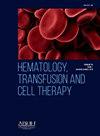Twice or once a day? Filgrastim dosing schedule for peripheral hematopoietic stem cells mobilization
IF 1.8
Q3 HEMATOLOGY
引用次数: 0
Abstract
Introduction
Granulocyte colony-stimulating factor (G-CSF) is the most prevalently used growth factor for peripheral blood hematopoietic stem cell (HSC) mobilization. Most centers split the granulocyte colony-stimulating factor in two daily doses, whereas some centers administer one dose per day. This study aims to investigate the effect of the filgrastim dosing schedule on the quantity of hematopoietic stem cells collected after mobilization in healthy donors.
Methods
A total of 251 healthy donors mobilized in our center were included in the study. Mobilization was either once a day (filgrastim 1 × 10 mg/kg/day) or twice a day (filgrastim 2 × 5 mg/kg/day).
Results
White blood cell and peripheral CD34+ cell numbers were significantly higher in the Twice-a-day Group on the fifth day compared to the Once-a-day Group. No statistically significant difference was shown between the two groups regarding the number of CD34+ cells collected on the first apheresis day or the number of apheresis procedures needed to achieve the targeted number of CD34+ cells.
Conclusion
This study revealed that one daily dose of 10 mg/kg filgrastim is as effective as administering the same dose split on two days for an adequate amount of CD34+ cells in healthy donors.
一天两次还是一次?用于外周造血干细胞动员的菲格司汀剂量表
粒细胞集落刺激因子(G-CSF)是外周血造血干细胞(HSC)动员中最常用的生长因子。大多数中心将粒细胞集落刺激因子分成每天两次的剂量,而有些中心每天只给一次剂量。本研究旨在探讨非格司汀给药方案对健康供体动员后收集的造血干细胞数量的影响。方法选取本中心动员的251例健康献血者作为研究对象。每天1次(非格拉西汀1 × 10 mg/kg/天)或每天2次(非格拉西汀2 × 5 mg/kg/天)。结果与1天1次组相比,2天1次组第5天白细胞和外周血CD34+细胞数量明显增加。两组在第一个采珠日收集的CD34+细胞数量或达到CD34+细胞目标数量所需的采珠次数均无统计学差异。结论本研究表明,对于健康供者足够数量的CD34+细胞,每天给药10mg /kg的非格昔汀与两天给药相同剂量的非格昔汀同样有效。
本文章由计算机程序翻译,如有差异,请以英文原文为准。
求助全文
约1分钟内获得全文
求助全文
来源期刊

Hematology, Transfusion and Cell Therapy
Multiple-
CiteScore
2.40
自引率
4.80%
发文量
1419
审稿时长
30 weeks
 求助内容:
求助内容: 应助结果提醒方式:
应助结果提醒方式:


